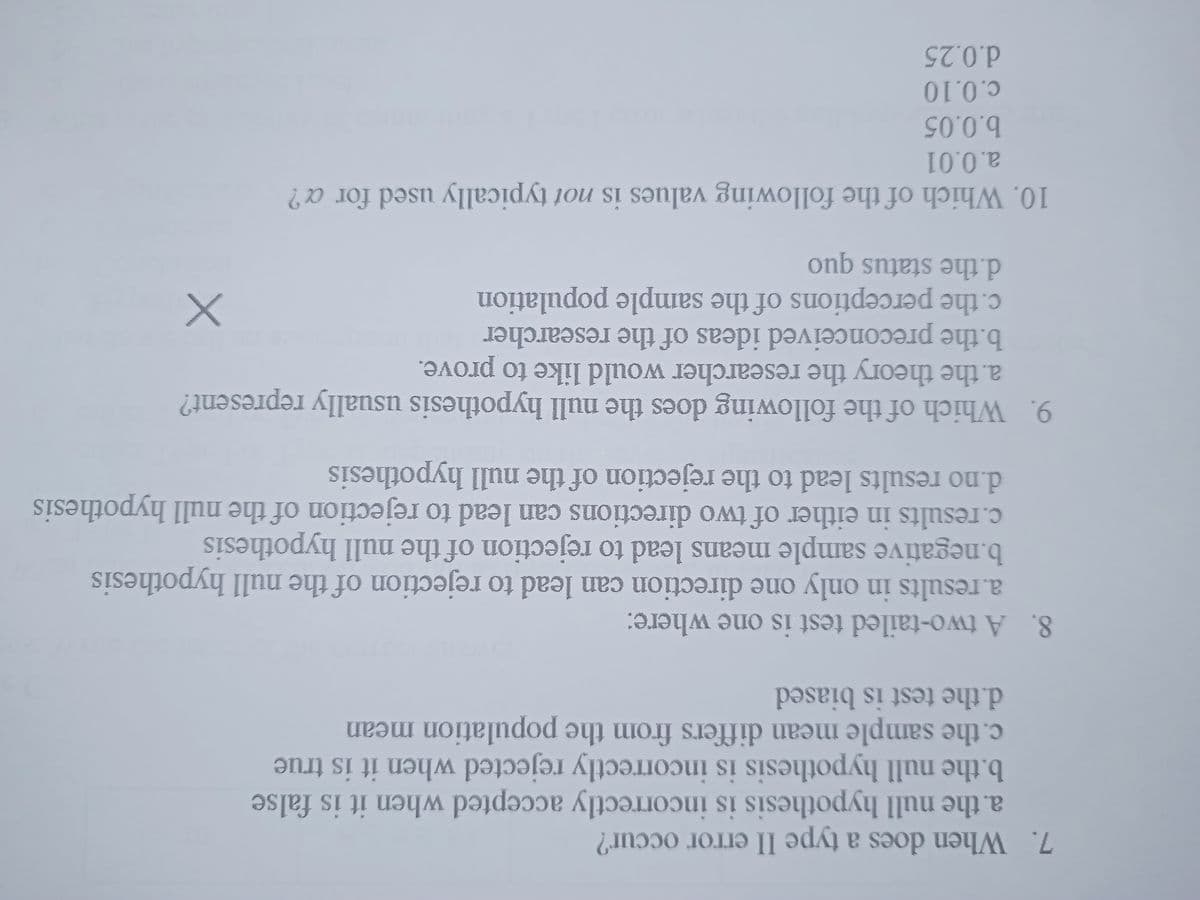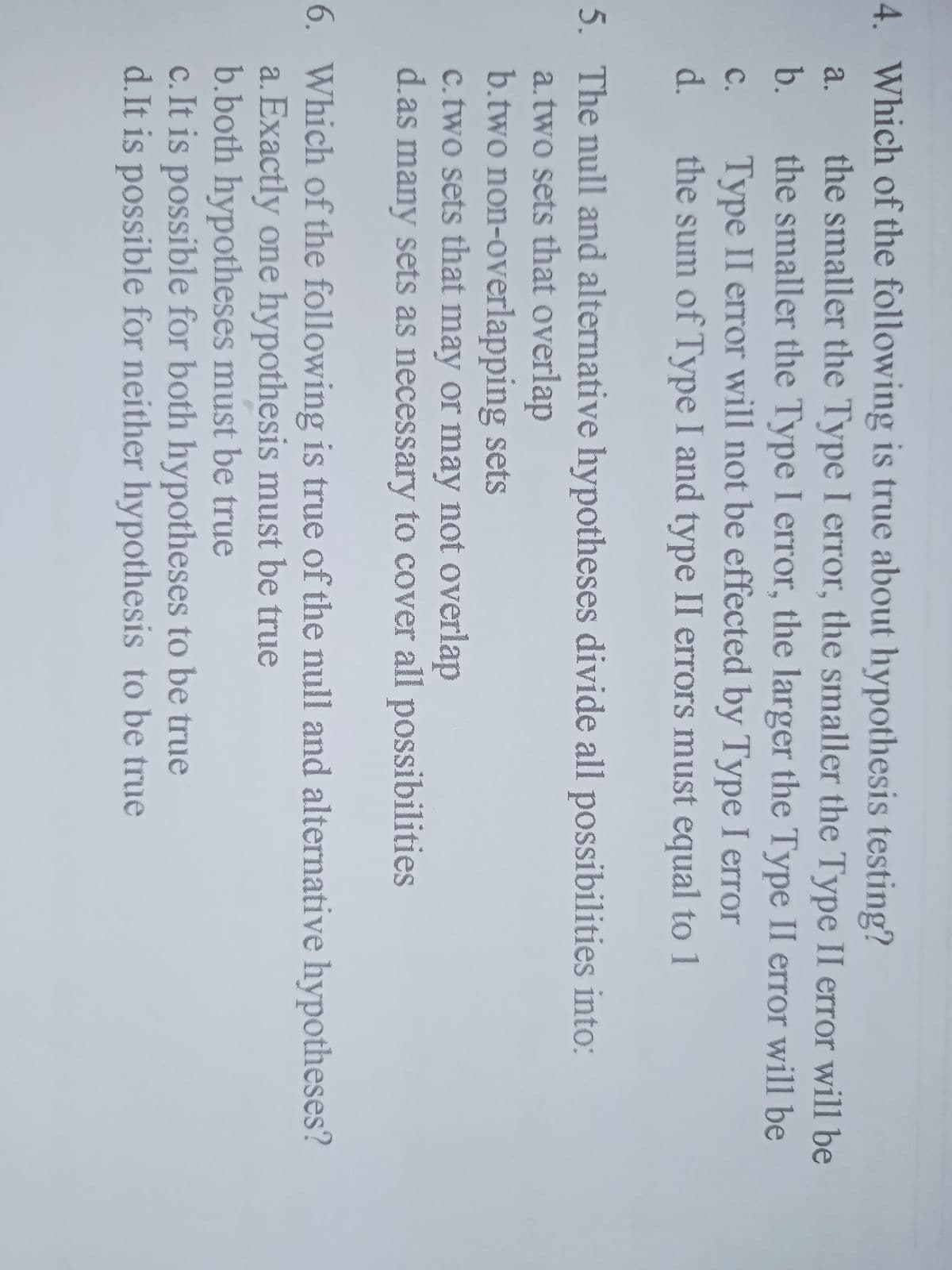4. Which of the following is true about hypothesis testing? the smaller the Type I error, the smaller the Type II error will b the smaller the Type I error, the larger the Type II error will be Type II error will not be effected by Type I error the sum of Type I and type II errors must equal to 1 a. b. C. d. 5. The null and alternative hypotheses divide all possibilities into: a. two sets that overlap b.two non-overlapping sets c. two sets that may or may not overlap d.as many sets as necessary to cover all possibilities 6. Which of the following is true of the null and alternative hypotheses? a. Exactly one hypothesis must be true b.both hypotheses must be true c. It is possible for both hypotheses to be true d.It is possible for neither hypothesis to be true
4. Which of the following is true about hypothesis testing? the smaller the Type I error, the smaller the Type II error will b the smaller the Type I error, the larger the Type II error will be Type II error will not be effected by Type I error the sum of Type I and type II errors must equal to 1 a. b. C. d. 5. The null and alternative hypotheses divide all possibilities into: a. two sets that overlap b.two non-overlapping sets c. two sets that may or may not overlap d.as many sets as necessary to cover all possibilities 6. Which of the following is true of the null and alternative hypotheses? a. Exactly one hypothesis must be true b.both hypotheses must be true c. It is possible for both hypotheses to be true d.It is possible for neither hypothesis to be true
A First Course in Probability (10th Edition)
10th Edition
ISBN:9780134753119
Author:Sheldon Ross
Publisher:Sheldon Ross
Chapter1: Combinatorial Analysis
Section: Chapter Questions
Problem 1.1P: a. How many different 7-place license plates are possible if the first 2 places are for letters and...
Related questions
Topic Video
Question
Kindly pls, answer this:)

Transcribed Image Text:7. When does a type II error occur?
a. the null hypothesis is incorrectly accepted when it is false
b.the null hypothesis is incorrectly rejected when it is true
c. the sample mean differs from the population mean
d.the test is biased
8. A two-tailed test is one where:
a.results in only one direction can lead to rejection of the null hypothesis
b.negative sample means lead to rejection of the null hypothesis
c.results in either of two directions can lead to rejection of the null hypothesis
d.no results lead to the rejection of the null hypothesis
9. Which of the following does the null hypothesis usually represent?
a. the theory the researcher would like to prove.
b.the preconceived ideas of the researcher
d.the status quo
c. the perceptions of the sample population
10. Which of the following values is not typically used for a?
a.0.01
b.0.05
c.0.10
d.0.25

Transcribed Image Text:4. Which of the following is true about hypothesis testing?
the smaller the Type I error, the smaller the Type II error will be
the smaller the Type I error, the larger the Type II error will be
a.
b.
Type II error will not be effected by Type I error
the sum of Type I and type II errors must equal to 1
C.
d.
5. The null and alternative hypotheses divide all possibilities into:
a.two sets that overlap
b.two non-overlapping sets
c.two sets that may or may not overlap
d.as many sets as necessary to cover all possibilities
6. Which of the following is true of the null and alternative hypotheses?
a. Exactly one hypothesis must be true
b.both hypotheses must be true
c. It is possible for both hypotheses to be true
d.It is possible for neither hypothesis to be true
Expert Solution
This question has been solved!
Explore an expertly crafted, step-by-step solution for a thorough understanding of key concepts.
This is a popular solution!
Trending now
This is a popular solution!
Step by step
Solved in 4 steps

Knowledge Booster
Learn more about
Need a deep-dive on the concept behind this application? Look no further. Learn more about this topic, probability and related others by exploring similar questions and additional content below.Recommended textbooks for you

A First Course in Probability (10th Edition)
Probability
ISBN:
9780134753119
Author:
Sheldon Ross
Publisher:
PEARSON


A First Course in Probability (10th Edition)
Probability
ISBN:
9780134753119
Author:
Sheldon Ross
Publisher:
PEARSON
